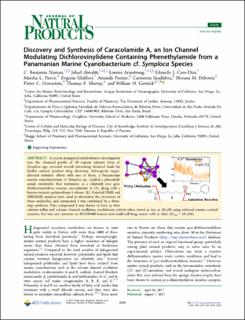| dc.contributor.author | Naman, C. Benjamin | |
| dc.contributor.author | Almaliti, Jehad | |
| dc.contributor.author | Armstrong, Lorene | |
| dc.contributor.author | Caro-Díaz, Eduardo J. | |
| dc.contributor.author | Pierce, Marsha L. | |
| dc.contributor.author | Glukhov, Evgenia | |
| dc.contributor.author | Fenner, Amanda | |
| dc.contributor.author | Spadafora, Carmenza | |
| dc.contributor.author | Debonsi, Hosana M. | |
| dc.contributor.author | Dorrestein, Pieter C. | |
| dc.contributor.author | Murray, Thomas F. | |
| dc.contributor.author | Gerwick, William H. | |
| dc.date.accessioned | 2020-06-26T03:57:41Z | |
| dc.date.available | 2020-06-26T03:57:41Z | |
| dc.date.issued | 2017-08-07 | |
| dc.identifier.other | DOI: 10.1021/acs.jnatprod.7b00367 | |
| dc.identifier.uri | http://repositorio-indicasat.org.pa/handle/123456789/116 | |
| dc.description | A recent untargeted metabolomics investigation into the chemical profile of 10 organic extracts from cf. Symploca spp. revealed several interesting chemical leads for further natural product drug discovery. Subsequent targetdirected isolation efforts with one of these, a Panamanian marine cyanobacterium cf. Symploca sp., yielded a phenethylamide metabolite that terminates in a relatively rare gemdichlorovinylidene moiety, caracolamide A (1), along with a known isotactic polymethoxy-1-alkene (2). Detailed NMR and HRESIMS analyses were used to determine the structures of these molecules, and compound 1 was confirmed by a threestep synthesis. Pure compound 1 was shown to have in vitro calcium influx and calcium channel oscillation modulatory activity when tested as low as 10 pM using cultured murine cortical neurons, but was not cytotoxic to NCI-H460 human non-small-cell lung cancer cells in vitro (IC50 > 10 μM). | en_US |
| dc.description.abstract | A recent untargeted metabolomics investigation into the chemical profile of 10 organic extracts from cf. Symploca spp. revealed several interesting chemical leads for further natural product drug discovery. Subsequent targetdirected isolation efforts with one of these, a Panamanian marine cyanobacterium cf. Symploca sp., yielded a phenethylamide metabolite that terminates in a relatively rare gemdichlorovinylidene moiety, caracolamide A (1), along with a known isotactic polymethoxy-1-alkene (2). Detailed NMR and HRESIMS analyses were used to determine the structures of these molecules, and compound 1 was confirmed by a threestep synthesis. Pure compound 1 was shown to have in vitro calcium influx and calcium channel oscillation modulatory activity when tested as low as 10 pM using cultured murine cortical neurons, but was not cytotoxic to NCI-H460 human non-small-cell lung cancer cells in vitro (IC50 > 10 μM). | en_US |
| dc.format | application/pdf | |
| dc.language.iso | eng | en_US |
| dc.rights | Info:eu-repo/semantics/openAccess | |
| dc.rights | https://creativecommons.org/licenses/by/4.0/ | |
| dc.subject | Discovery and Synthesis | en_US |
| dc.subject | Modulating Dichlorovinylidene | en_US |
| dc.subject | Panamanian Marine | en_US |
| dc.title | Discovery and Synthesis of Caracolamide A, an Ion Channel Modulating Dichlorovinylidene Containing Phenethylamide from a Panamanian Marine Cyanobacterium cf. Symploca Species | en_US |
| dc.type | info:eu-repo/semantics/article | en_US |
| dc.type | Info:eu-repo/semantics/publishedversion | |

